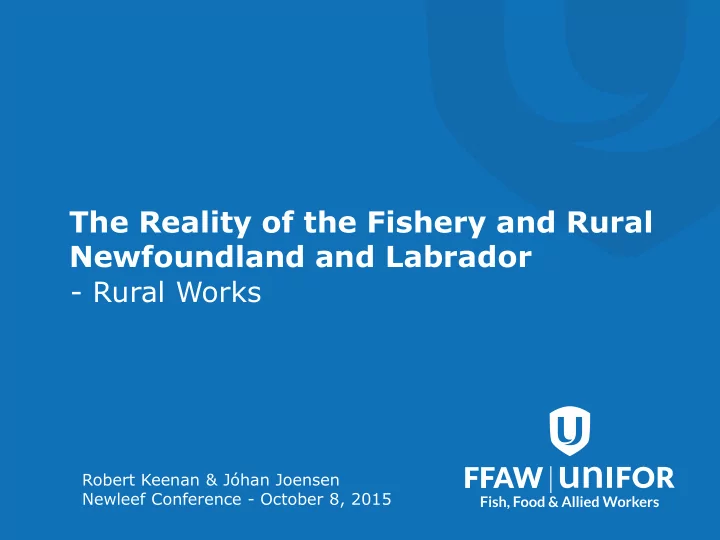

The Reality of the Fishery and Rural Newfoundland and Labrador - Rural Works Robert Keenan & Jóhan Joensen Newleef Conference - October 8, 2015
What is FFAW-Unifor Founded in 1971 by Father Des McGrath and • Richard Cashin Represent workers in fisheries, shipping, metal • fabrication, brewing, security and hospitality Membership number today is ~12,000 living in • over 600 communities Affiliated with Canada’s largest private sector • union – Unifor represents more than 305,000 workers 2
Engagement Roles • Collective bargaining • Policy and Regulatory Advocate • Develop harvesting plans • Supporting better returns on exports • Own Science Department 3
Two Important Marine Industries for Newfoundland & Labrador Fishing industry provides Petroleum royalties direct employment of contribute ~28% of the almost 18,000 people in Provincial Government rural NL Revenue (Source: Department of Fisheries & (Source: Department of Finance – Aquaculture - Year in Review, 2013) Economic Review 2014) 4
Two Fundamental Elements of Our Province • Settled based on abundance adjacency and access • Cod sustained our province for almost 500 years • Environmental shifts led to species composition changes • Development of Petroleum Resources in last two decades 5
Two Fundamental Elements of Our Province • Government Revenue • Significant Reliance on Royalty Regimes • 28% of revenue from oil and gas, add to this other industrial development • Employment in Support of Petroleum Installations • 4,592 NL Residents (CNLOPB) • Hebron in construction employing 4,012 for NL • Direct employment from fishing industry approximately 18,000 in the province • Most are employed in Small and Medium Sized Enterprises • Based in rural areas of the province 6
Changing Context • Harvesting patterns modified by species compositions • Environment • Market Demands • Petroleum Industry • Expanding Scope • Continued increase in Demonstrative maps from a C-NLOPB presentation: 2015 – Possibility for 2017 – 20% under licence/CFB/Sector competing needs 7
A Delicate Balance • Fishing and Petroleum Industries continue to provide economic opportunities to benefit Newfoundland and Labrador. • The issue to keep in mind is: How we development and continue our dependence on a non-renewable resource without detriment to a sustainable and renewable industry – a perceived dying industry. 8
Myth Making – is NL a Post-Fishing Province?
Roots of the Myth • The moratorium. • Horrendous economic climate = mass outmigration from rural areas. • No effort to stop the outmigration; relying on the fishery for rural economic growth an unstated mistake. • Those who are left we hear little about.
Doing Away With the Myth Relying on the fishery was never a mistake for • rural NL; the mistake was in the management. A lot of lessons learned since the moratorium: • • Diversify – now ten notable fisheries; no one fishery worth more than 35% of total fishery • Focused on value: the better the product, the more economically sustainable the fishery. The fishery could be the brightest economic light • in NL this year: • Total value in 2015 in excess of $1 billion, most of which flowing through rural NL.
Rural Works – The Goal • To build vibrant, sustainable rural economies around the fishery.
Rural Works – The Logic of the Goal The current inshore fishery with better management (in excess of $1 billion annual value) The new northern cod fishery (estimated value: $400-$500 million annually) Supports a re-purposed fishery that focuses on better jobs, higher pay, and a longer season
Rural Works – The Hurdles • Addresses three converging issues: • Securing adjacency as the primary fisheries management principle; • Securing and managing the new northern cod fishery; • Rural depopulation.
Securing Adjacency • Adjacency: Those who live closest to the resource are the primary beneficiaries of the resource. • Guiding allocation principle since the early 1980s. • Now ignored for shrimp and halibut; adjacency completely removed from the groundfish management plan.
Securing the Northern Cod Fishery • The northern cod fishery will once again be a substantial fishery in the next 1 to 3 years. • In the years before the moratorium, the inshore fleet was guaranteed the first 115,000mt of the northern cod quota. • Not seeking to rebuild the cod fishery of yesteryear. Focus is on high-quality and high value product.
A Rural Repopulation Strategy • The success of the rural fishing economy is explicitly tied to a sustainable rural population. • The FFAW’s population strategy is straight-forward - JOBS • Need to create better fishery sector jobs in rural NL.
Rural Works – The Campaign Phase One • Coalition Building • Coalition Activity: lobbying, rallies, media campaign, support pledges Phase Two – Build off phase one success • Organize and implement new approach to the fishery • Work with business and municipal partners to maximize value of new fishery
For more information on adjacency and its importance to coastal communities, please visit: www.ffaw.nf.ca @FFAW_Unifor #ruralworks
THANK YOU
Recommend
More recommend